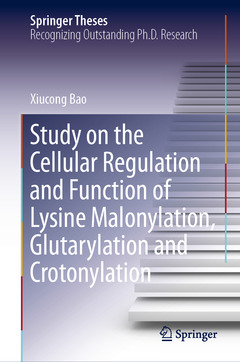Description
Study on the Cellular Regulation and Function of Lysine Malonylation, Glutarylation and Crotonylation, 1st ed. 2020
Springer Theses Series
Language: English
Subjects for Study on the Cellular Regulation and Function of Lysine...:
Study on the Cellular Regulation and Function of Lysine Malonylation, Glutarylation and Crotonylation
Publication date: 03-2020
Support: Print on demand
Publication date: 03-2020
Support: Print on demand
Study on the Cellular Regulation and Function of Lysine Malonylation, Glutarylation and Crotonylation
Publication date: 03-2021
163 p. · 15.5x23.5 cm · Paperback
Publication date: 03-2021
163 p. · 15.5x23.5 cm · Paperback
Description
/li>Contents
/li>Comment
/li>
This book presents pioneering findings on the characterization of cellular regulation and function for three recently identified protein posttranslational modifications (PTMs): lysine malonylation (Kmal), glutarylation (Kglu) and crotonylation (Kcr). It addresses three main topics: (i) Detecting Kmal substrates using a chemical reporter, which provides important information regarding the complex cellular networks modulated by Kmal; (ii) Identifying Kglu as a new histone PTM and assessing the direct impact of histone Kglu on chromatin structure and dynamics; and (iii) Revealing Sirt3?s value as a regulating enzyme for histone Kcr dynamics and gene transcription, which opens new avenues for examining the physiological significance of histone Kcr. Taken together, these studies provide information critical to understanding how these protein PTMs are associated with various human diseases, and to identifying therapeutic targets for the dysregulation of these novel protein markers in varioushuman diseases.
Introduction to Protein Posttranslational Modifications (PTMs).- Chemical reporter for Lysine Malonylation.- Identification of Histone Lysine Glutarylation.- Glutarylation at Histone H4 lysine 91 Modulates Chromatin Assembly.- Identification of Sirt3 as an ‘Eraser’ for Histone Lysine Crotonylation Marks using a Chemical Proteomics Approach.
Nominated as an outstanding Ph.D. thesis by the University of Hong Kong Reports on important advances in the study of histone posttranslational modifications (PTMs) Introduces applications of the CLASPI approach in identifying ‘eraser’ enzymes for histone PTMs Discusses chemical reporters for protein posttranslational modifications Unravels the role of histone modifications in the regulation of chromatin structure
© 2024 LAVOISIER S.A.S.




